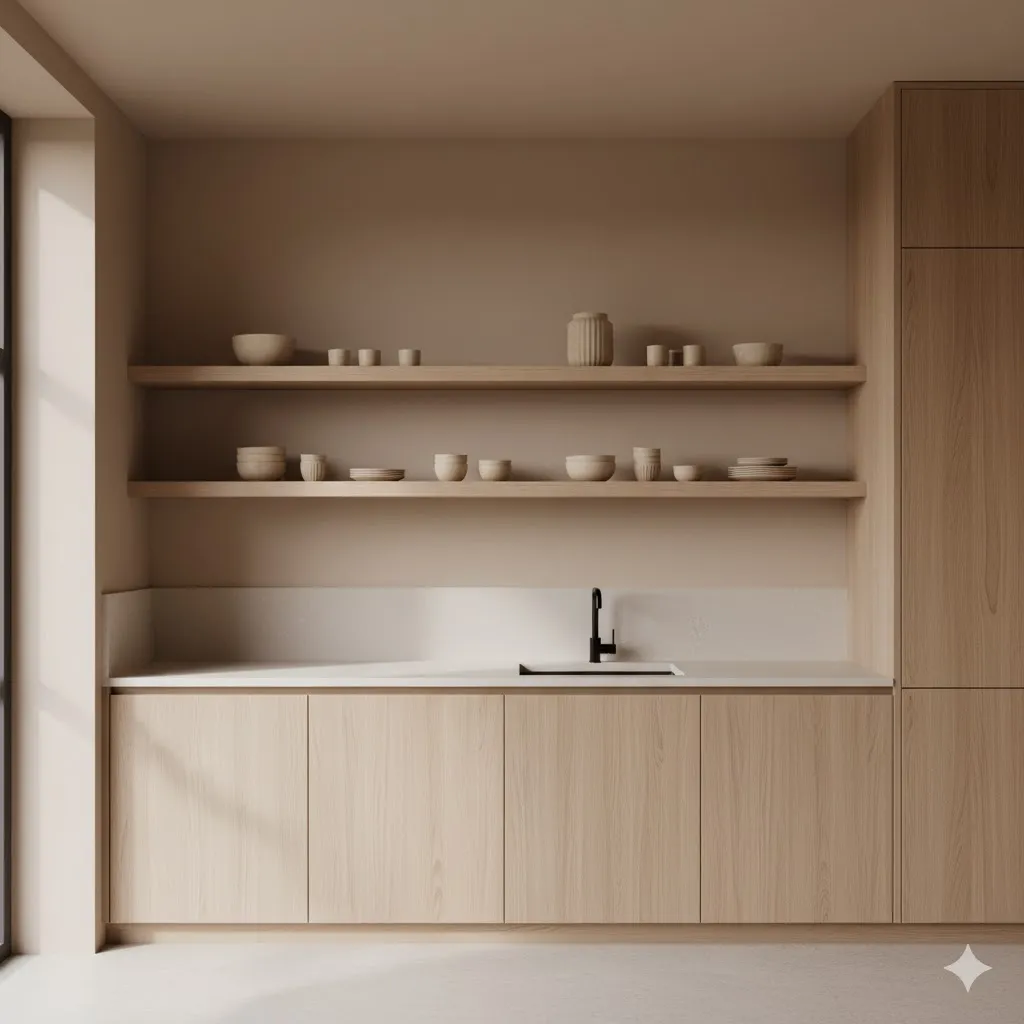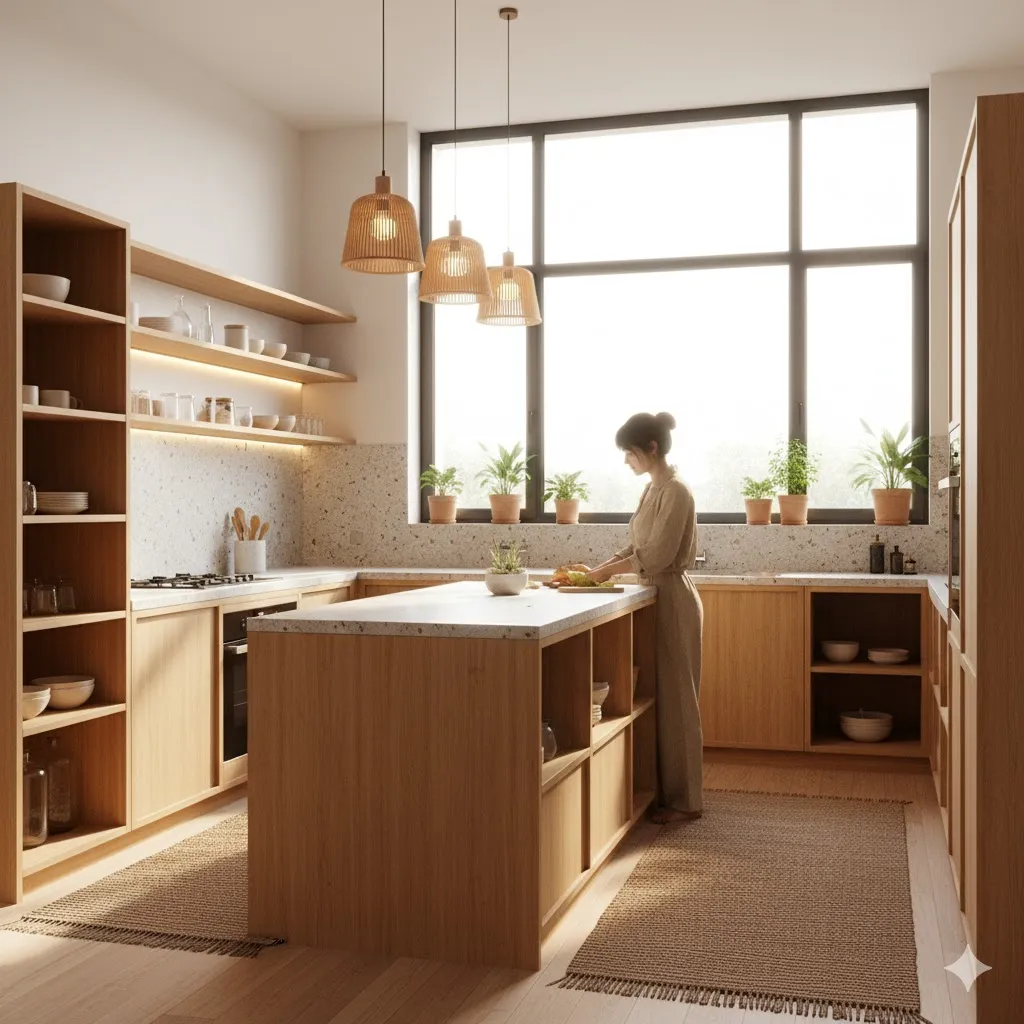15 Modern Japandi Kitchen Design: Where Japan Meets Scandinavia
Japandi kitchen design is a beautiful fusion of two timeless design philosophies — Japanese minimalism and Scandinavian simplicity. This style blends the Zen calm of Japan with the cozy warmth of Nordic homes, creating a space that feels peaceful, balanced, and inviting. The Japandi kitchen isn’t just about aesthetics; it’s about creating a lifestyle centered on mindfulness, function, and harmony. Whether you’re remodeling your kitchen or designing a new one, embracing Japandi style can turn it into a serene retreat where beauty meets purpose.
The Essence of Japandi Style
Japandi Kitchen Design is all about balance — between clean design and natural comfort, simplicity and warmth, elegance and functionality. The style highlights minimal clutter, natural materials, and calming colors that soothe the senses. It’s not about showing off luxury but appreciating the quiet beauty in everyday life. Japandi kitchens celebrate the “less is more” philosophy, proving that simplicity can indeed be the ultimate sophistication.

Why Japandi Design Is So Popular
In today’s fast-paced world, many people are drawn to the peaceful and grounded feeling that Japandi Kitchen Design brings. It promotes mindfulness and relaxation — two things everyone craves at home. The aesthetic’s simplicity and eco-friendly approach also make it a favorite among modern homeowners. With its neutral tones, natural textures, and clean design, the Japandi kitchen feels timeless yet refreshing. It’s no wonder this trend continues to dominate modern interior design.

1. Minimalist Beauty with Purpose
At the heart of Japandi kitchen design lies intentional minimalism. Every item serves a purpose, and unnecessary clutter is removed. The result is a space that looks clean, open, and calming. Cabinets are sleek, surfaces are tidy, and décor is minimal but meaningful. This approach doesn’t mean your kitchen will feel empty — it’ll feel airy and serene, with space to breathe and move freely.

2. Natural Materials for Authentic Warmth
Japandi Kitchen Design celebrates the beauty of nature through materials like wood, bamboo, rattan, and stone. These elements bring a grounded warmth that balances the minimalist structure. For example, pairing oak cabinets with stone countertops adds both texture and comfort. Natural materials not only look timeless but also make your kitchen feel more organic and alive — a true reflection of nature’s harmony.

3. Soft Neutral Color Palettes
Color sets the tone in Japandi kitchens. Instead of bright or bold hues, this style favors soft, muted neutrals — think beige, cream, soft gray, taupe, and warm whites. These colors create a calming backdrop and help light flow naturally through the room. You can add subtle contrast with darker tones like charcoal or deep brown for depth and balance.

4. Clean Lines and Simple Forms
Japandi Kitchen Design thrive on simplicity. Straight lines, smooth surfaces, and uncluttered shapes define the space. Cabinets are often handle-less, creating a sleek and uninterrupted flow. The key is to choose furniture and fixtures that are visually simple yet beautifully crafted. This combination of clean form and craftsmanship makes the kitchen feel effortlessly elegant.

5. Functional and Clutter-Free Spaces
Functionality is essential in Japandi Kitchen Design. Every corner of the kitchen is thoughtfully organized to make daily life easier. Open shelving, built-in storage, and hidden drawers help keep surfaces tidy. The idea is to eliminate visual chaos so you can cook, clean, and relax in a peaceful environment. A clutter-free space equals a clutter-free mind — a core principle of Japandi living.

6. Combining Wood and Stone Elements
A Japandi Kitchen Design often blends wood and stone for texture and contrast. For instance, light oak cabinets might be paired with a marble or granite countertop. The natural grain of wood complements the cool, smooth feel of stone beautifully. This mix symbolizes harmony — warmth meets strength, soft meets solid. It’s an artful balance that gives your kitchen depth and timeless appeal.

7. Bringing Nature Indoors
Nature plays a vital role in Japandi Kitchen Design interiors. To bring the outdoors inside, add potted plants, dried flowers, or even a small bonsai on your kitchen counter. Large windows that let in sunlight enhance the airy, natural atmosphere. Using natural materials like linen or cotton for curtains and seating adds another layer of calm, connecting your home with the outside world.

8. Smart Lighting for a Calm Ambience
Lighting in a Japandi Kitchen Design should feel soft and natural. Avoid harsh overhead lights and opt for warm LED fixtures, pendant lights, or lantern-inspired designs. Under-cabinet lighting can add a gentle glow that enhances functionality without overpowering the mood. The goal is to create a calm, inviting atmosphere that encourages relaxation and mindfulness.

9. Sleek Storage Solutions
Storage in a Japandi Kitchen Design is both smart and subtle. Think built-in cabinets with clean lines, hidden drawers, and multi-purpose furniture. Open shelves can display a few meaningful items, like handmade pottery or simple ceramic bowls. Everything should have its place, but without overwhelming the space. The cleaner and more organized your kitchen looks, the more serene it feels.

10. Open Layouts for Flow and Balance
Japandi Kitchen Design values open spaces and smooth flow. An open-plan kitchen with a dining area encourages family interaction and light movement. Instead of walls, consider using sliding glass panels or low partitions to maintain connection while preserving intimacy. This design not only enhances visual balance but also makes your kitchen feel larger and airier.

11. Subtle Décor with Meaning
Japandi décor is minimal but intentional. Each piece has a purpose, whether it’s a vase, a painting, or a bowl. Choose items that reflect peace, craftsmanship, and nature. Handmade ceramics, woven baskets, and natural textures add character without clutter. Remember: less decoration doesn’t mean less personality — it means every item matters more.

12. Sustainable and Eco-Friendly Touches
Sustainability is a cornerstone of Japandi philosophy. Use eco-friendly materials like bamboo, reclaimed wood, and non-toxic paints. Opt for energy-efficient appliances and LED lights to reduce your environmental footprint. The focus on sustainability not only benefits the planet but also creates a healthier, longer-lasting home.

13. Japandi-Inspired Kitchen Furniture
Furniture in a Japandi kitchen is simple, functional, and crafted from natural materials. A solid wood dining table, minimalist stools, or bench seating can add authenticity. Avoid overly ornate designs — instead, look for sleek silhouettes and soft finishes. The goal is to create an environment where every piece contributes to the overall balance.

14. Blending Tradition with Modernity
Japandi style is the perfect marriage of tradition and modern living. It honors the heritage of Japanese craftsmanship and Scandinavian practicality while embracing modern conveniences. You can include smart appliances, sleek fixtures, or contemporary lighting — as long as they blend seamlessly with natural textures and soft colors. This balance keeps your kitchen timeless and functional.

15. Tips to Create Your Own Japandi Kitchen
To design your own Japandi kitchen, start by simplifying. Remove clutter, choose neutral tones, and focus on quality over quantity. Mix wood and stone textures, and bring in plants or natural light whenever possible. Stick to furniture with clean lines and avoid over-decoration. Remember, Japandi design is less about perfection and more about harmony, peace, and simplicity.

Conclusion – Finding Balance Through Design
A modern Japandi kitchen is more than just a space for cooking — it’s a sanctuary for the soul. It’s where simplicity meets beauty, and function meets mindfulness. By merging the best of Japanese and Scandinavian design, you create a kitchen that inspires calmness, balance, and happiness in everyday living. The Japandi kitchen reminds us that home is not about having more; it’s about finding joy in less.
FAQs About Japandi Kitchen Design
1. What is the main concept behind Japandi kitchen design?
It blends Japanese minimalism with Scandinavian coziness, focusing on simplicity, function, and harmony with nature.
2. What colors are used in Japandi kitchens?
Soft neutrals like beige, cream, white, taupe, and muted grays are popular, often accented with natural wood tones.
3. How can I make my kitchen feel more Japandi?
Use natural materials, declutter surfaces, add plants, and stick to neutral tones with clean, simple lines.
4. Is Japandi style expensive to achieve?
Not necessarily. You can start small by decluttering, adding wood textures, and using natural, budget-friendly décor.
5. What kind of lighting suits a Japandi kitchen?
Warm, soft lighting — pendant lights, under-cabinet LEDs, and paper-style lamps — helps create a peaceful mood.







